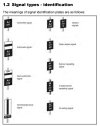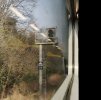A distant signal is a signal that is provided so that a driver has enough warning about a stop signal ahead being at danger. That’s why the distance between the relevant distant signal and the signal at danger is spaced at a minimum of the service braking distance.
The above signals were in some areas known as colour light repeaters, often shortened to repeater. Because in track circuit block sections where two aspect colour light signals are used, normally all stop signals can only show a red or a green, hence the distant signal can only show a yellow or a green. Hence the distant signal “repeats” what the stop signal is doing.
It’s important to note that a distant signal forms part of the aspect sequence.
This is totally different to what a banner repeater signal does. A banner repeater signal is only provided if there is the possibility that the required sighting distance cannot be achieved for a signal (or there is an operational advantage for some other reason where there is an advantage in a driver being given an earlier indication).
A banner repeater signal does not form part of the aspect sequence. It only tells a driver if the signal it is repeating is showing danger or a proceed aspect. Although there is now a LED type that can also show green if the signal is also showing green. Banner signals are normally fairly close to the signal that they repeat, often less than 200 yards (183 metres) away.
In terms of the suffix used on signal name plates, this varied across different railways over time.
For Western, typically R was used for colour light distant / colour light repeater signals (mechanical signals normally did not have signal name plates originally).
Banner signals typically used P, some used R, and more recently they used BR.
On Western, most had the same prefix and number as the signal they are/were repeating. But this has changed under the more modern standards.



